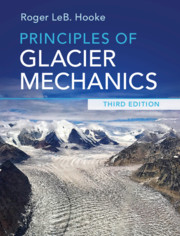99 results

Principles of Glacier Mechanics
-
- Published online:
- 20 December 2019
- Print publication:
- 05 December 2019
Preface to the third edition
-
- Book:
- Principles of Glacier Mechanics
- Published online:
- 20 December 2019
- Print publication:
- 05 December 2019, pp xiii-xiv
-
- Chapter
- Export citation
Preface to the second edition
-
- Book:
- Principles of Glacier Mechanics
- Published online:
- 20 December 2019
- Print publication:
- 05 December 2019, pp xv-xvi
-
- Chapter
- Export citation
1 - Why study glaciers?
-
- Book:
- Principles of Glacier Mechanics
- Published online:
- 20 December 2019
- Print publication:
- 05 December 2019, pp 1-4
-
- Chapter
- Export citation
7 - The coupling between a glacier and its bed
-
- Book:
- Principles of Glacier Mechanics
- Published online:
- 20 December 2019
- Print publication:
- 05 December 2019, pp 149-198
-
- Chapter
- Export citation
10 - Stress and velocity distribution in an idealized glacier
-
- Book:
- Principles of Glacier Mechanics
- Published online:
- 20 December 2019
- Print publication:
- 05 December 2019, pp 274-290
-
- Chapter
- Export citation
16 - Ice core studies
-
- Book:
- Principles of Glacier Mechanics
- Published online:
- 20 December 2019
- Print publication:
- 05 December 2019, pp 433-454
-
- Chapter
- Export citation
11 - Numerical modeling
-
- Book:
- Principles of Glacier Mechanics
- Published online:
- 20 December 2019
- Print publication:
- 05 December 2019, pp 291-319
-
- Chapter
- Export citation
2 - Some basic concepts
-
- Book:
- Principles of Glacier Mechanics
- Published online:
- 20 December 2019
- Print publication:
- 05 December 2019, pp 5-16
-
- Chapter
- Export citation
8 - Water flow in and under glaciers: Geomorphic implications
-
- Book:
- Principles of Glacier Mechanics
- Published online:
- 20 December 2019
- Print publication:
- 05 December 2019, pp 199-255
-
- Chapter
- Export citation
14 - Finite strain and the origin of foliation
-
- Book:
- Principles of Glacier Mechanics
- Published online:
- 20 December 2019
- Print publication:
- 05 December 2019, pp 387-407
-
- Chapter
- Export citation
12 - Applications of stress and deformation principles to classical problems
-
- Book:
- Principles of Glacier Mechanics
- Published online:
- 20 December 2019
- Print publication:
- 05 December 2019, pp 320-349
-
- Chapter
- Export citation
3 - Mass balance
-
- Book:
- Principles of Glacier Mechanics
- Published online:
- 20 December 2019
- Print publication:
- 05 December 2019, pp 17-45
-
- Chapter
- Export citation
Dedication
-
- Book:
- Principles of Glacier Mechanics
- Published online:
- 20 December 2019
- Print publication:
- 05 December 2019, pp v-vi
-
- Chapter
- Export citation
Index
-
- Book:
- Principles of Glacier Mechanics
- Published online:
- 20 December 2019
- Print publication:
- 05 December 2019, pp 506-514
-
- Chapter
- Export citation
5 - The velocity field in a glacier
-
- Book:
- Principles of Glacier Mechanics
- Published online:
- 20 December 2019
- Print publication:
- 05 December 2019, pp 81-114
-
- Chapter
- Export citation
Problems
-
- Book:
- Principles of Glacier Mechanics
- Published online:
- 20 December 2019
- Print publication:
- 05 December 2019, pp 455-464
-
- Chapter
- Export citation
13 - Ice streams and ice shelves
-
- Book:
- Principles of Glacier Mechanics
- Published online:
- 20 December 2019
- Print publication:
- 05 December 2019, pp 350-386
-
- Chapter
- Export citation
4 - Flow and fracture of a crystalline material
-
- Book:
- Principles of Glacier Mechanics
- Published online:
- 20 December 2019
- Print publication:
- 05 December 2019, pp 46-80
-
- Chapter
- Export citation
9 - Stress and deformation
-
- Book:
- Principles of Glacier Mechanics
- Published online:
- 20 December 2019
- Print publication:
- 05 December 2019, pp 256-273
-
- Chapter
- Export citation



